In the wake of the nationwide protests led by Gen-Z in Kenya on June 25, 2025, GeoPoll conducted a rapid survey to gauge public sentiment and perceptions surrounding the demonstrations. These protests, organized largely by youth activists and civil society groups, were a continuation of the growing dissent against government policies, police brutality, and economic hardship.
GeoPoll sought to capture the views of ordinary Kenyans on the causes, legitimacy, and impact of the protests. This report provides timely insights into how citizens across the country perceived the motivations, actors, and government response tied to the events of June 25. It also serves as a follow-up to the GeoPoll Research – Gen Z Protests in Kenya 2024, offering a comparative lens into how public sentiment has evolved over the past year.
At a glance
- Social media is the popular media of the June 25th protest, with 65% getting their information from social media.
- More than half of the respondents (57%) believe that nothing has changed between June 25th, 2024, and June 25th, 2025.
- Of those who physically participated in the protest, 66% had experienced looting, mugging, beatings, and even killings.
- Political dissatisfaction was the main reason for protesting by 31% of the respondents.
- A majority (38%) have very little trust in the government to respond appropriately to the protest concerns
Demographic Overview
The survey gathered responses from a diverse group of young Kenyans. Most respondents were aged 25-34 (52%), with a balanced representation of males (57%), and females (43%). A majority held college degrees (67%), while 49% were unemployed, and 18% owned small businesses. Respondents were predominantly from urban (70%) and rural (30%) areas.
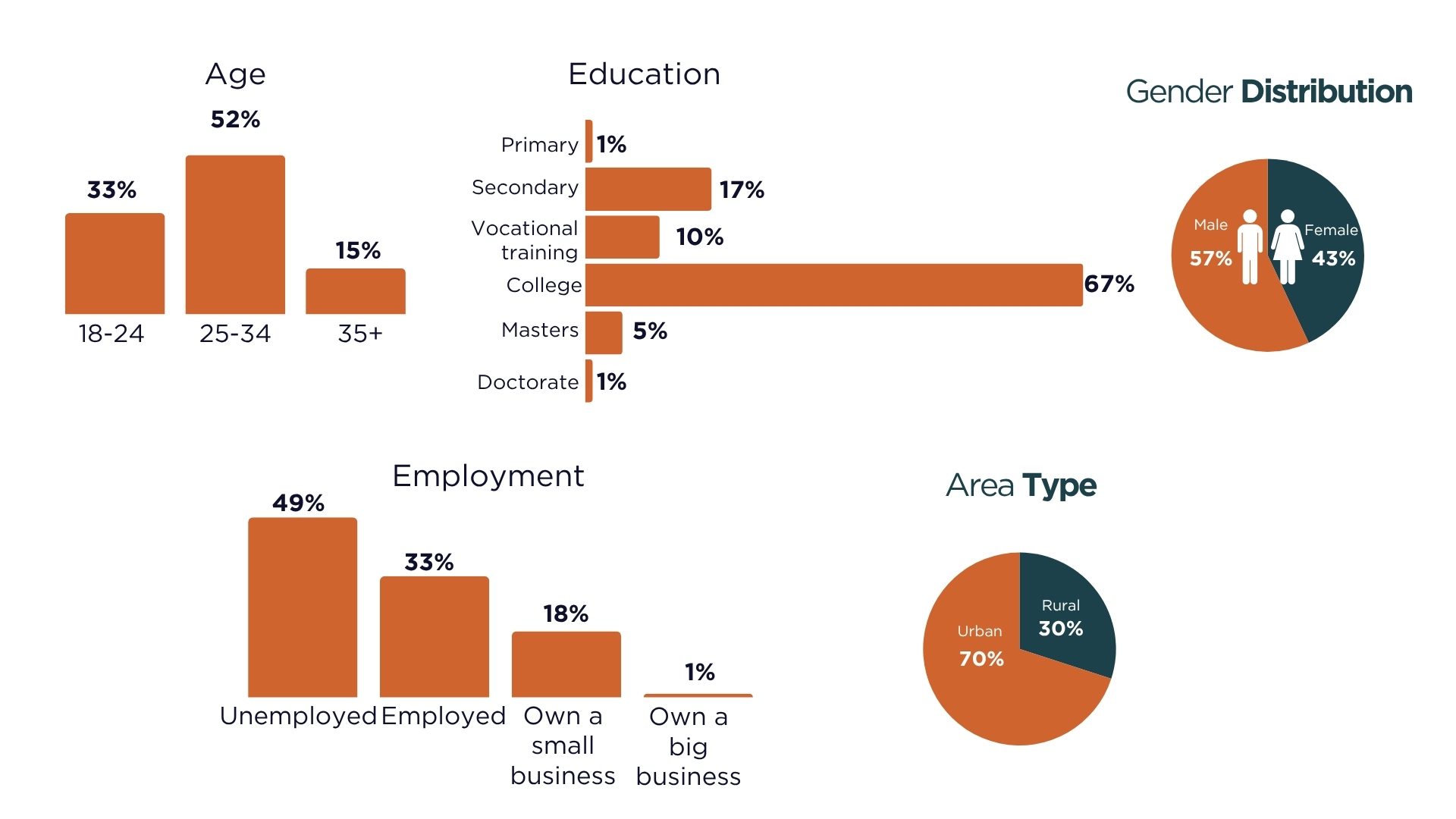
Key Findings
Awareness and Media Coverage
There was an overwhelming level of public awareness regarding the June 25, 2025, protests, with 97% of respondents indicating they were aware of the demonstrations. Social media was the dominant source of information, with 65% of respondents reporting that they relied on social media platforms for updates and developments, reflecting the growing influence of digital networks, especially among younger demographics, who primarily marshal crowds from social platforms.
During the protests, the government barred media houses from airing the protests live, which may be one of the reasons why television was the primary source of information for 26%, and radio was only a secondary source for 3%.
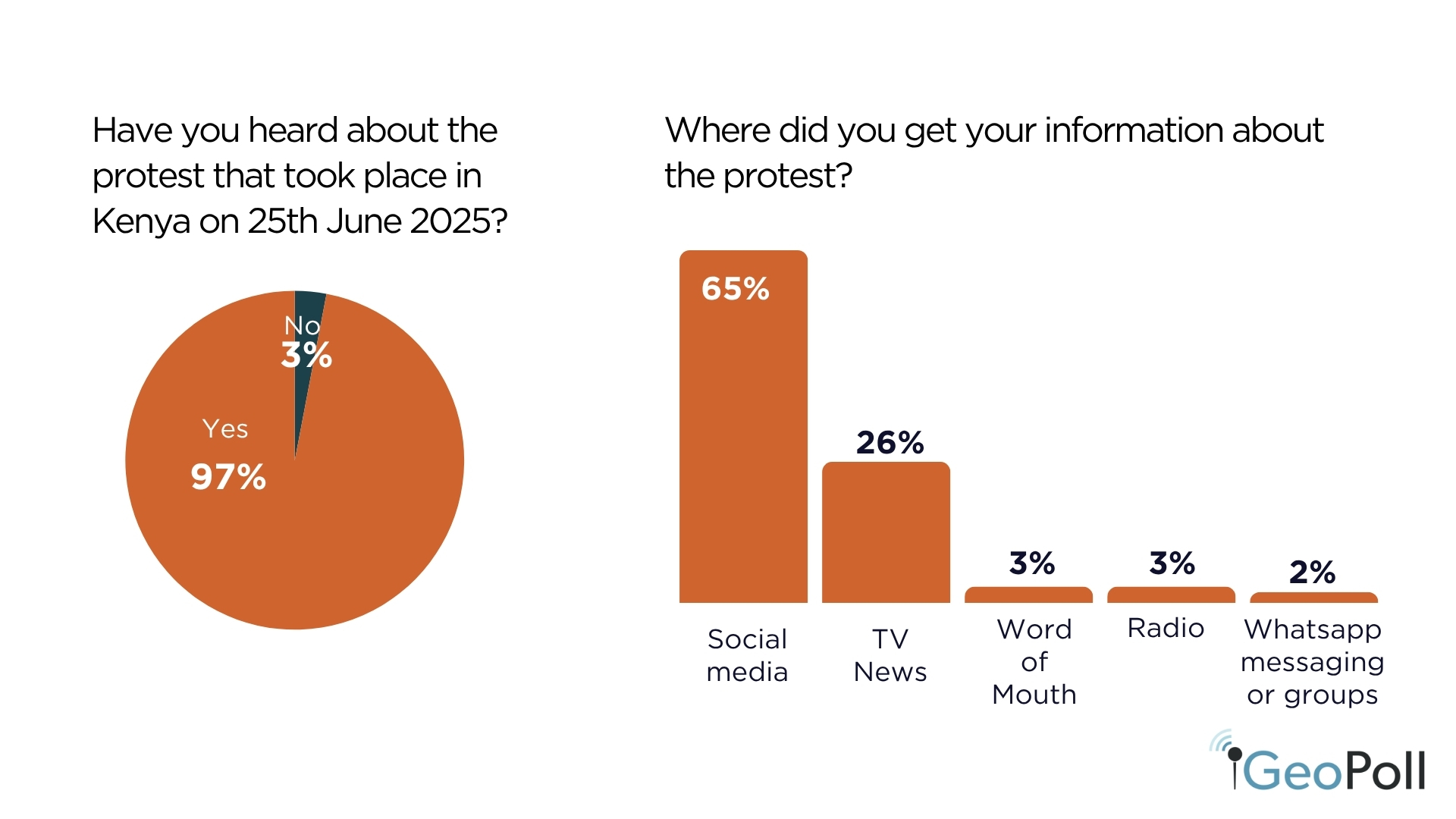
Media coverage of the protests was viewed mainly positively by the public. This sentiment persisted despite the fact that traditional media stations were barred from airing live footage of the protests. In response, many broadcasters continued their coverage through platforms like YouTube and other social media channels, where a significant portion of the public turned to follow developments in real-time.
A combined 65% of respondents rated the coverage as either “very good” or “good”, suggesting that most felt the media did a commendable job in reporting the events. Another 25% rated the coverage as “fair,” while only a small minority considered it “poor” (8%) or “very poor” (4%).
Most trusted media source
Despite being the primary source of information for only 26%, television emerged as the clear leader when respondents were asked about their most trusted sources of information during the protests, with 65% of respondents.
Social media platforms followed, with TikTok (42%), Twitter (38 %), and Facebook (33%) reflecting the significant role of digital channels in shaping public perception. Traditional media like radio (24%) and newspapers (17%) still held relevance, but at much lower trust levels. Online news websites (22%) and messaging apps like WhatsApp (18%) were also noted, while influencers (15%) and other sources (2%) ranked lowest. These results highlight a diverse media landscape, where both traditional and digital platforms play crucial roles, but television remains the most trusted outlet for the majority.
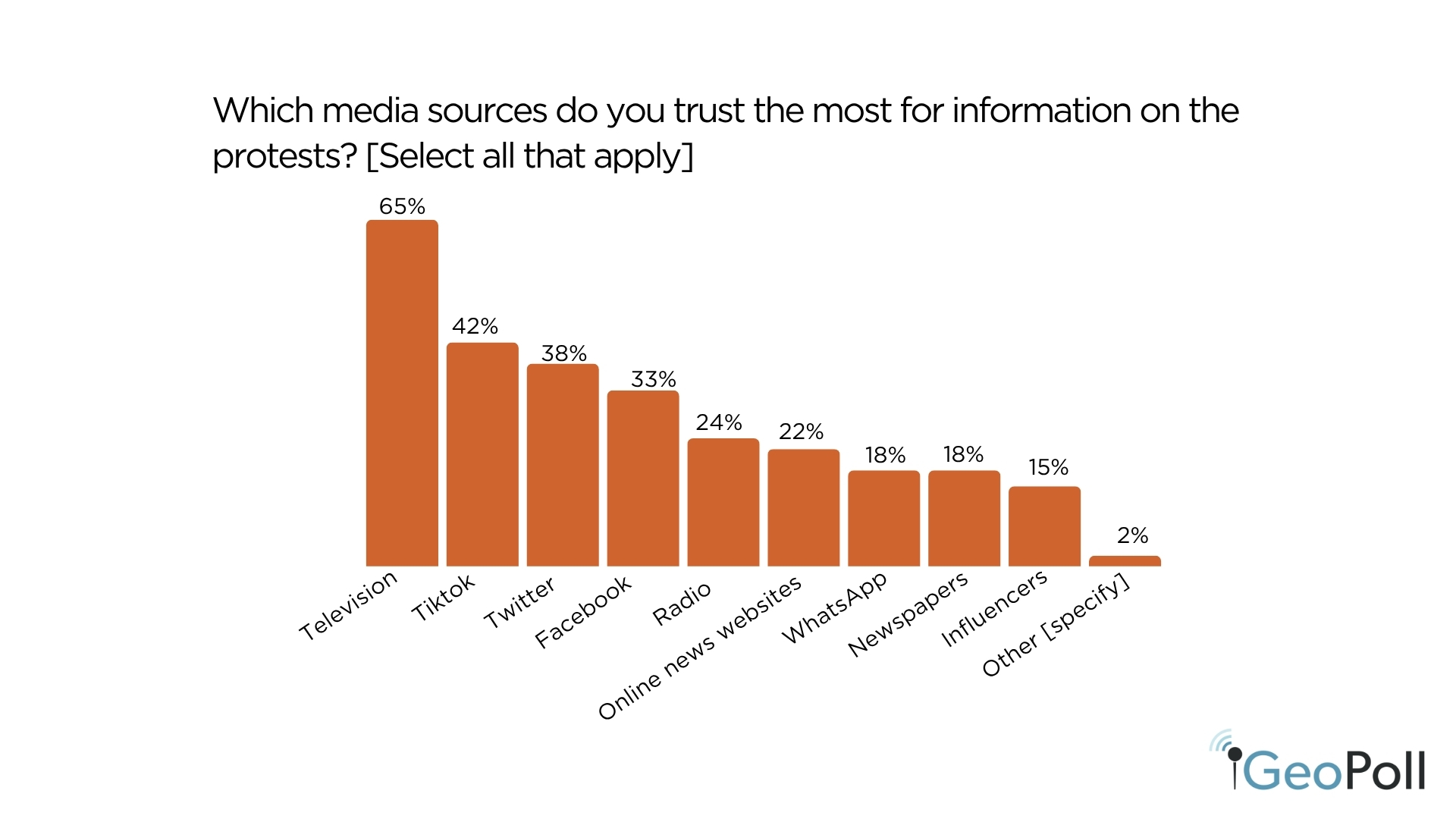
Political events, such as demonstrations, can be outlets for misinformation. We sought to know if the respondents verify the information they consume, and 46% of respondents reported that they always verify the news and information they consume, while 32% stated that they do so frequently. This suggests a strong culture of media vigilance and fact-checking among the public, particularly during periods of heightened civic engagement.
What has changed between 25th June 2024 and 25th June 2025?
Those surveyed were asked to compare the state of the country following the protests of June 25, 2024, to those in 2025; 57% expressed the belief that nothing had really changed.
This sentiment reflects a widespread perception of stagnation in governance, accountability, and socio-economic conditions, despite the significant national and international attention that the 2024 protests received. The results indicate that for most Kenyans, the promises of reform and open dialogue made after last year’s demonstrations have not led to any real improvements. This deep sense of disillusionment may be fueling ongoing civic unrest and the persistent demand for systemic change.
57% said nothing had really changed between 25th June 2024 and 25th June 2025
Protests participation
The survey found that 60% of respondents participated in the protests on June 25, 2025, either by attending in person or by supporting the movement online. In contrast, 40% chose not to take part. This demonstrates a notable level of civic engagement and highlights the growing importance of both physical protests and digital activism in shaping Kenya’s sociopolitical landscape.
Alarmingly, among those who protested in person, 66% reported encountering incidents of looting, mugging, physical assault, or even fatal violence. These findings point to the significant risks faced by demonstrators and raise serious concerns about safety, police conduct, and the broader security environment surrounding public protests in the country.
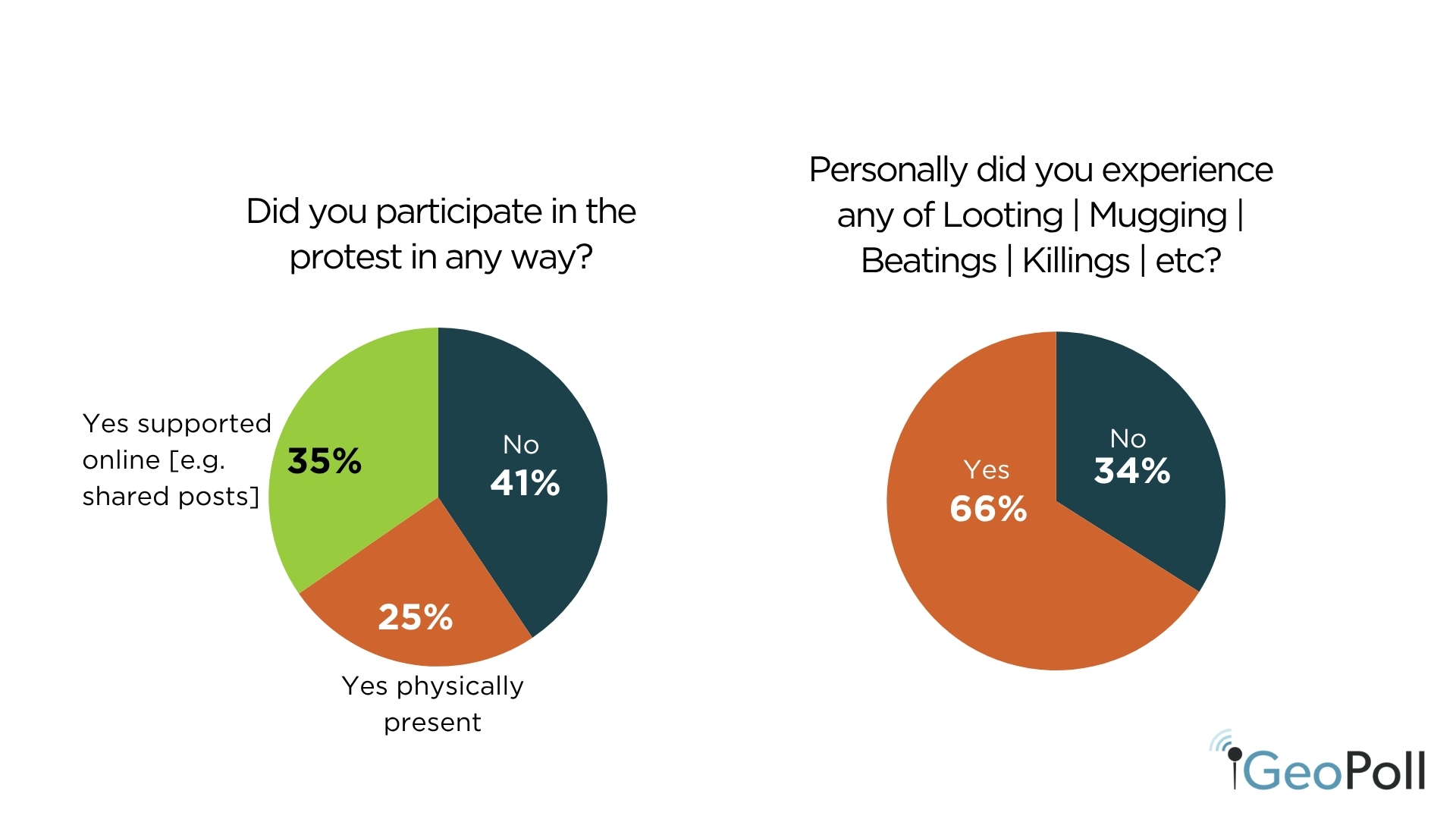
Personal Effects of the Protest
The protests had a wide range of personal effects on Kenyans, as highlighted in the survey findings. Fifty-six percent of respondents reported being unable to access transportation, which significantly disrupted their mobility and daily routines. Roughly 51% experienced heightened fear or anxiety, demonstrating the psychological toll of the unrest.
Additionally, 41% indicated that their businesses were disrupted, reflecting the economic impact of the demonstrations. The protests also disrupted education and employment, with 35% stating they were unable to attend work or school. While 14% of respondents said they were not affected, a concerning 8% reported being injured or harassed, pointing to the physical dangers present during the protests. These figures underscore the far-reaching and multifaceted impact of the protests on individual lives nationwide.
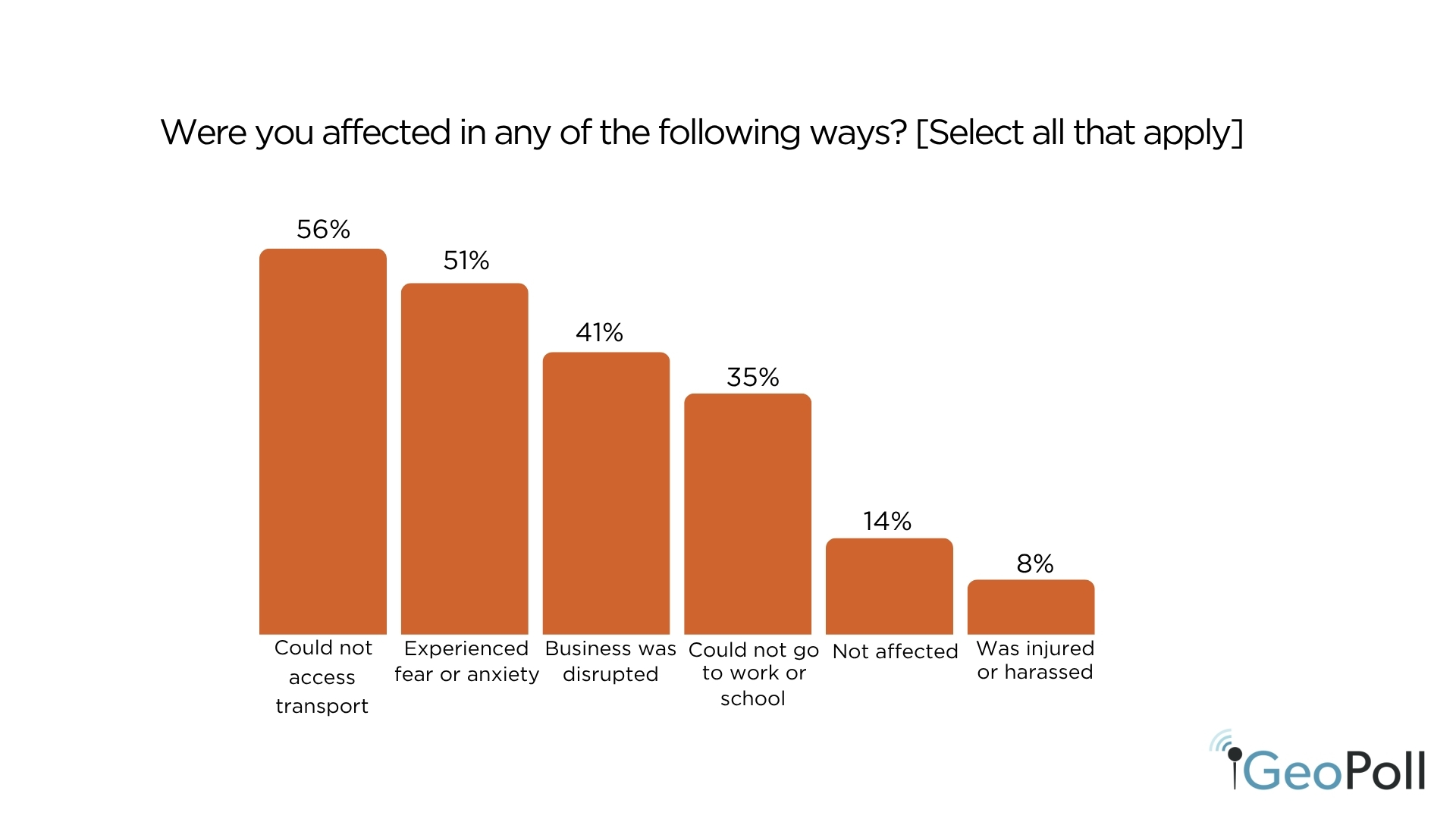
The Main Reasons for the Protests
In 2024, the Finance Bill, economic hardship, and misgovernance dominated the conversation, with citizens expressing outrage over inflated living costs, unaccountable leadership, and a lack of job opportunities. In contrast, the 2025 survey reveals that political dissatisfaction has surpassed economic concerns as the primary reason for protest (31%), while the cost of living has decreased to 22% and corruption to just 9%. Youth unemployment and taxation remain persistent issues, but the data suggests that frustrations have evolved from specific grievances to broader disillusionment with the political system, indicating a deepening mistrust in governance and a rising demand for structural change.
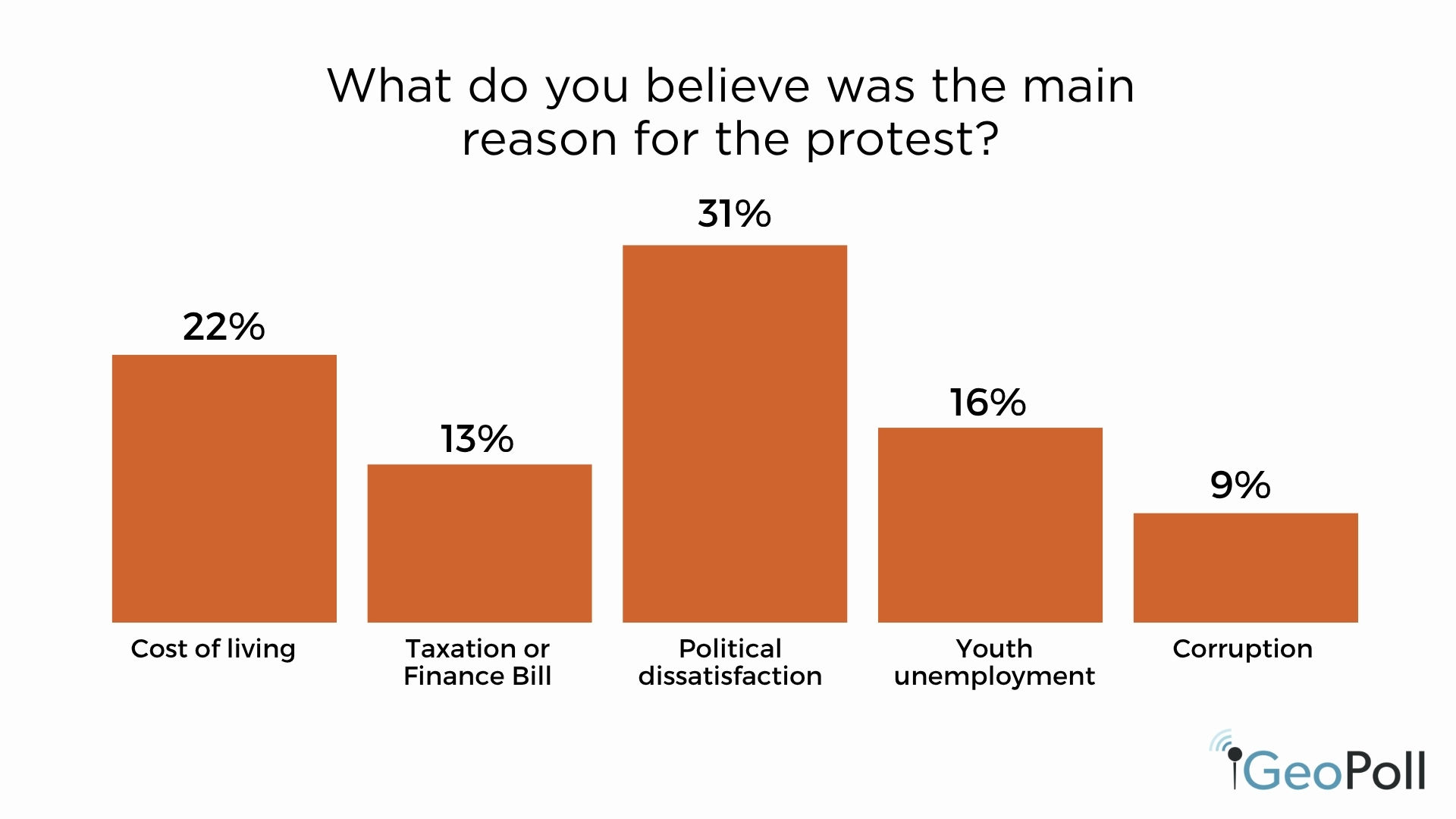
Impact of the Protests
When asked whether the June 25, 2025 protests would lead to any impact, public opinion appeared divided. About 34% of respondents believed the protests would result in some minor changes, reflecting cautious optimism about incremental progress. Meanwhile, 25% felt that no changes would occur, underscoring skepticism about the government’s willingness to respond meaningfully. Roughly 22% were more hopeful, anticipating significant changes as a result of the demonstrations. An additional 21% were unsure, indicating uncertainty about the outcome of the protest. These responses suggest that while a segment of the population holds onto hope for reform, a substantial portion remains doubtful or unconvinced of any lasting impact.
Views on the government
Based on the findings, public trust in the government to address the concerns raised during the protests is notably low. A combined 63% of respondents indicated minimal confidence, 38% said they trust the government “very little,” and 26% said “not at all.” Only 24% expressed a moderate level of trust by selecting “somewhat,” while just 14% reported having “very much” trust.
71% of respondents indicated that their voice is not being heard by the government. Only 11% felt that their concerns are being acknowledged, while 18% were unsure. In addition, the vast majority of respondents, 79% believe that the government is not addressing the needs of the youth. Only 8% felt that youth concerns are being taken into account, while 12% were unsure.
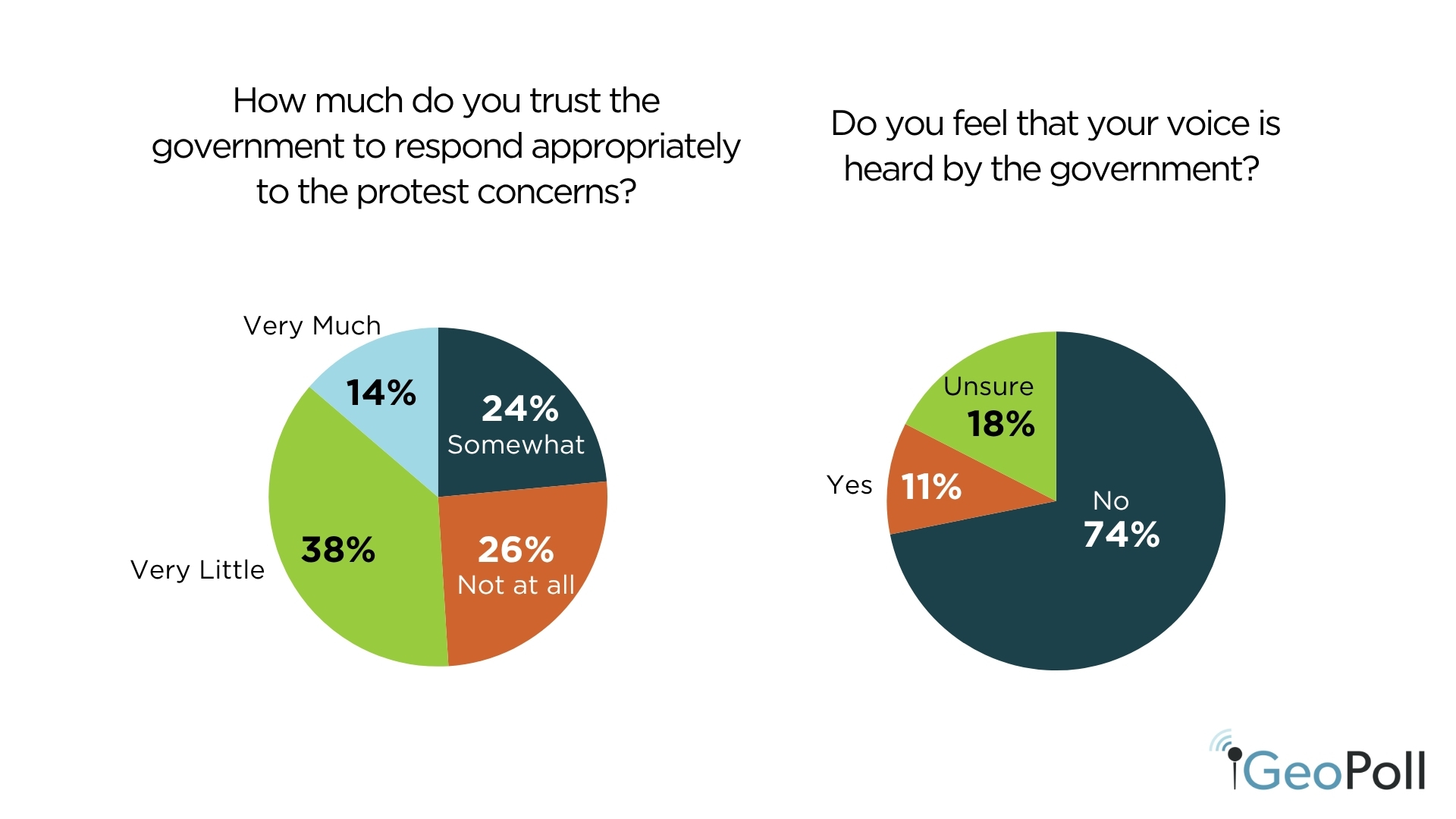
Biggest Concerns
Similar to last year, the top three concerns among Kenyans have remained largely consistent, with unemployment (89%), corruption (84%), and the cost of living (82%) continuing to dominate public anxiety. In 2025, these issues still top the list, though in slightly different order with unemployment (85%) remaining the most cited concern, followed closely by the cost of living (84%) and corruption (82%). Notably, concern for , while education (19%) and security (28%) have shifted slightly, suggesting evolving priorities but a continued focus on socio-economic and governance-related challenges.
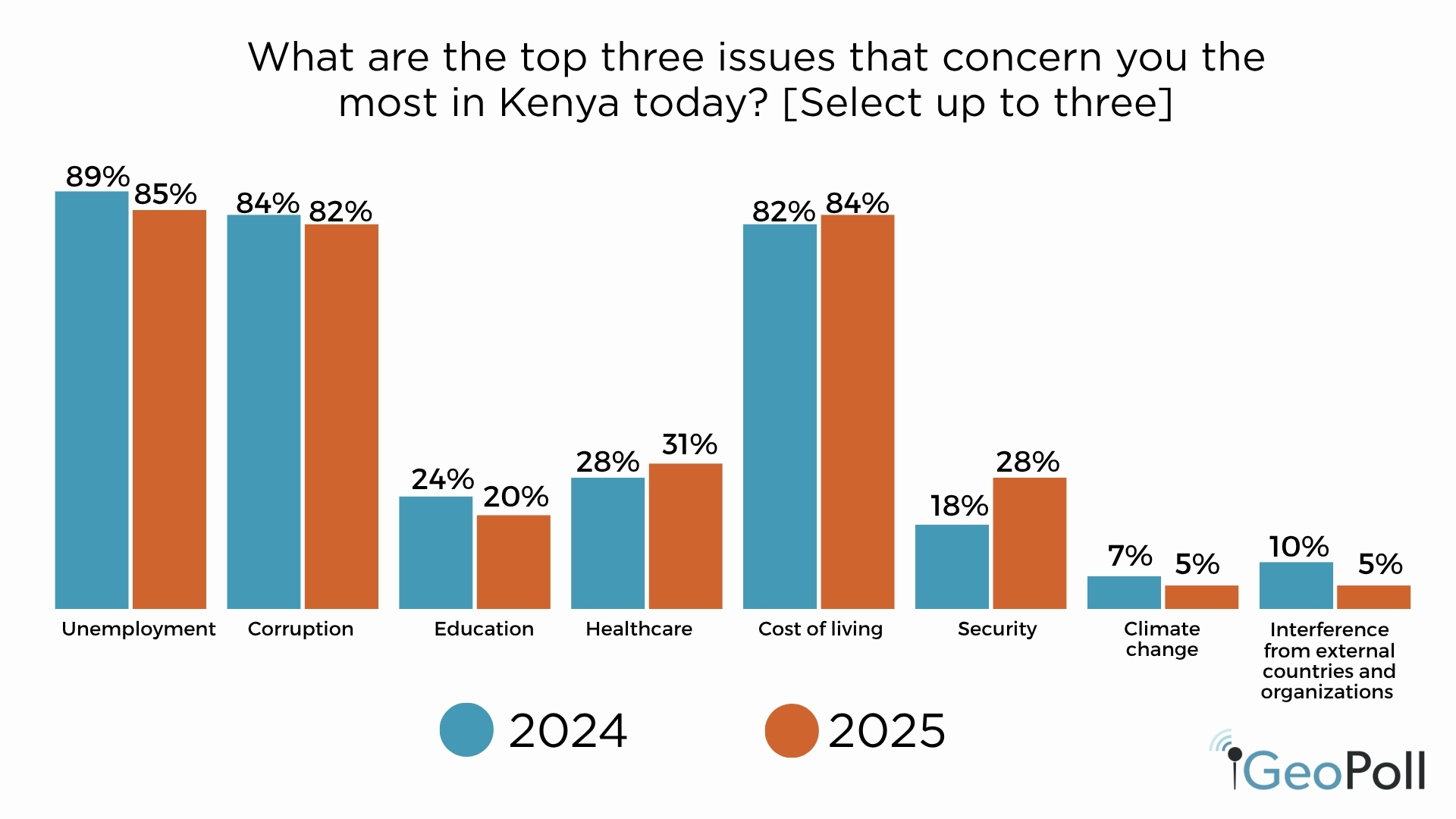
What must change for the protests to stop
We asked open-ended questions of those surveyed, inquiring about what must change for the protests to cease. The responses reveal that the top demand for ending protests is leadership change, cited by 42% of participants. This is followed by calls for youth empowerment and employment (13%) and tackling corruption (12%). Other key demands include economic reform, ending abductions and killings, and greater public inclusion in decision-making. This shows a strong desire among citizens for transformative political and governance reforms as a means to restore public trust and stability.
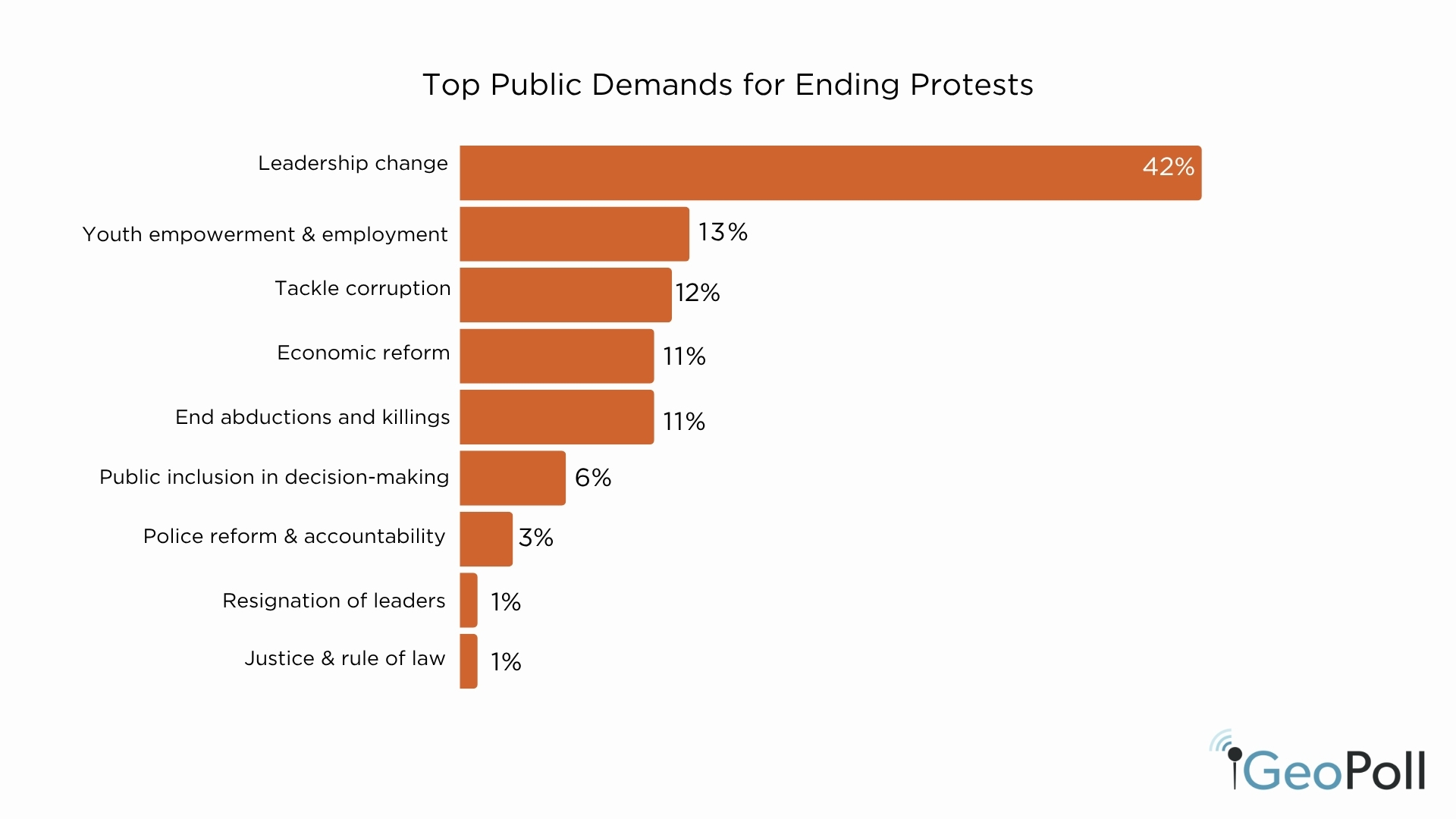
The top demand for ending protests is leadership change , cited by 42% of participants.
Methodology/About this Survey
This Exclusive Survey was conducted via the GeoPoll mobile application on June 26, 2025, in Kenya. The sample size consisted of 915 randomly selected GeoPoll users aged 18 and above. Since the survey was randomly distributed and conducted online, the results are slightly skewed toward younger respondents.
However, this demographic tilt aligns well with the nature of the June 25, 2025 protests, which were predominantly youth-led, making the findings especially representative of the core participants and voices behind the demonstrations.
GeoPoll is committed to empowering youth by supporting organizations, policymakers, and governments in addressing future challenges young people face. Together, we can leverage data to drive targeted interventions, enhance youth well-being, and build more resilient systems for the future. Our mobile-based surveys provide a robust and proven method for capturing insights on youth perspectives, behaviors, and public perceptions, particularly in under-resourced regions.
Please contact us to learn more about our capabilities, explore youth-focused topics, or other subjects in Africa, Asia, and Latin America.







